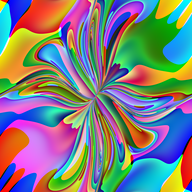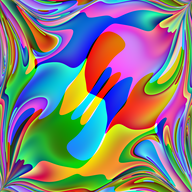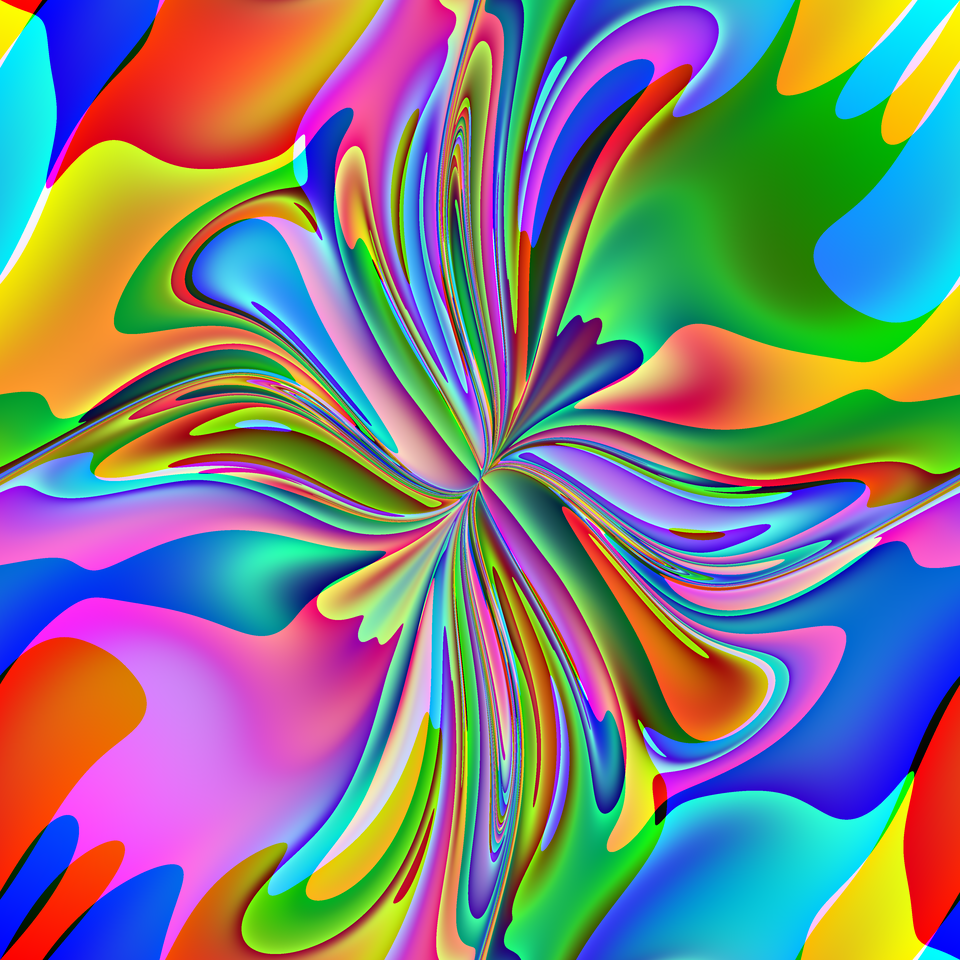Mitch Richling: Double Pendulum Chaos
| Author: | Mitch Richling |
| Updated: | 2025-01-23 |
Table of Contents
1. Introduction
This page was inspired by a reddit!
The equations of motion for the double pendulum may be written as a system of first degree differential equations:
Where
The idea is to run a double pendulum simulation for each pixel. Each pixel is mapped to a pair of angles – the x coordinate is mapped to
Two ways are provided to map pixels to angles controlled by the boolean CENTER. If it's true, then the angles are mapped left to right & top to bottom
from false, we map from CENTER is true the larger angles are at the
center of the image, and they are at the corners otherwise.
2. Code
#include "ramCanvas.hpp" #include "MRMathCPP.hpp" int main(void) { std::chrono::time_point<std::chrono::system_clock> startTime = std::chrono::system_clock::now(); const bool CENTER = true; const int IMXSIZ = 7680/2; const int IMYSIZ = 7680/2; const double m1 = 1.0; const double m2 = 1.0; const double L1 = 1.0; const double L2 = 1.0; const int steps = 200; const double h = 0.01; const double g = 9.80665; const double p = std::numbers::pi; mjr::ramCanvas3c8b theRamCanvas(IMXSIZ, IMYSIZ); if (CENTER) theRamCanvas.newRealCoords(0, 2*p, 0, 2*p); else theRamCanvas.newRealCoords(-p, p, -p, p); theRamCanvas.clrCanvasToBlack(); # pragma omp parallel for schedule(static,1) for(int y=0;y<theRamCanvas.getNumPixY();y++) { if ((y%100)==0) std::cout << y << std::endl; for(int x=0;x<theRamCanvas.getNumPixX();x++) { double theta1 = theRamCanvas.int2realX(x); double omega1 = 0.0; double theta2 = theRamCanvas.int2realY(y); double omega2 = 0.0; for(int i=0; i<steps; i++) { double cd = cos(theta1-theta2); double sd = sin(theta1-theta2); double o12 = omega1*omega1; double o22 = omega2*omega2; double denom = 2*m1+m2-m2*cos(2*theta1-2*theta2); double new_omega1 = (-g*(2*m1+m2)*sin(theta1)-m2*g*sin(theta1-2*theta2)-2*sd*m2*(o22*L2+o12*L1*cd))/(L1*denom); double new_omega2 = (2*sd*(o12*L1*(m1+m2)+g*(m1+m2)*cos(theta1)+o22*L2*m2*cd))/(L2*denom); theta1 += h*omega1; omega1 += h*new_omega1; theta2 += h*omega2; omega2 += h*new_omega2; } double r = mjr::math::ivl::wrapCO(theta2, 2*p)/(2*p); double b = mjr::math::ivl::wrapCO(theta1, 2*p)/(2*p); double g = mjr::math::ivl::wrapCC((omega1+omega2)/(4*p), 1.0); theRamCanvas.getPxColorRefNC(x, y).setChansRGB_dbl(r, g, b); } } theRamCanvas.writeTIFFfile((CENTER ? "doublePendulum_center.tiff" : "doublePendulum_corner.tiff")); std::chrono::duration<double> runTime = std::chrono::system_clock::now() - startTime; std::cout << "Total Runtime " << runTime.count() << " sec" << std::endl; return 0; }
Source Link: doublePendulum.cpp
The above program will generate the following images (the first is with CENTER=true):
3. Making A Movie!
We can animate the above process, and drop a movie frame for every time step. The program below demonstrates one of the neat features of
MRaster – we can create images that have floating point doubles as pixels. I'm using that feature below to store
the four values (
#include "ramCanvas.hpp" #include "MRMathCPP.hpp" int main(void) { std::chrono::time_point<std::chrono::system_clock> startTime = std::chrono::system_clock::now(); const bool CENTER = true; const int NUMFRM = 1080; const int IMXSIZ = 7680/8; const int IMYSIZ = 7680/8; const double m1 = 1.0; const double m2 = 1.0; const double L1 = 1.0; const double L2 = 1.0; const double h = 0.01; const double g = 9.80665; const double p = std::numbers::pi; mjr::ramCanvas1c64F theta1canvas(IMXSIZ, IMYSIZ); mjr::ramCanvas1c64F omega1canvas(IMXSIZ, IMYSIZ); mjr::ramCanvas1c64F theta2canvas(IMXSIZ, IMYSIZ); mjr::ramCanvas1c64F omega2canvas(IMXSIZ, IMYSIZ); mjr::ramCanvas3c8b pcolorCanvas(IMXSIZ, IMYSIZ); if (CENTER) pcolorCanvas.newRealCoords(0, 2*p, 0, 2*p); else pcolorCanvas.newRealCoords(-p, p, -p, p); pcolorCanvas.clrCanvasToBlack(); for(int frame=0; frame<NUMFRM; frame++) { # pragma omp parallel for schedule(static,1) for(int y=0;y<pcolorCanvas.getNumPixY();y++) { for(int x=0;x<pcolorCanvas.getNumPixX();x++) { double theta1, omega1, theta2, omega2; if (frame == 0) { theta1 = pcolorCanvas.int2realX(x); omega1 = 0.0; theta2 = pcolorCanvas.int2realY(y); omega2 = 0.0; } else { theta1 = theta1canvas.getPxColorRefNC(x, y).getC0(); omega1 = omega1canvas.getPxColorRefNC(x, y).getC0(); theta2 = theta2canvas.getPxColorRefNC(x, y).getC0(); omega2 = omega2canvas.getPxColorRefNC(x, y).getC0(); double cd = cos(theta1-theta2); double sd = sin(theta1-theta2); double o12 = omega1*omega1; double o22 = omega2*omega2; double denom = 2*m1+m2-m2*cos(2*theta1-2*theta2); double new_omega1 = (-g*(2*m1+m2)*sin(theta1)-m2*g*sin(theta1-2*theta2)-2*sd*m2*(o22*L2+o12*L1*cd))/(L1*denom); double new_omega2 = (2*sd*(o12*L1*(m1+m2)+g*(m1+m2)*cos(theta1)+o22*L2*m2*cd))/(L2*denom); theta1 += h*omega1; omega1 += h*new_omega1; theta2 += h*omega2; omega2 += h*new_omega2; } theta1canvas.drawPoint(x, y, theta1); omega1canvas.drawPoint(x, y, omega1); theta2canvas.drawPoint(x, y, theta2); omega2canvas.drawPoint(x, y, omega2); double r = mjr::math::ivl::wrapCO(theta2, 2*p)/(2*p); double b = mjr::math::ivl::wrapCO(theta1, 2*p)/(2*p); double g = mjr::math::ivl::wrapCC((omega1+omega2)/(4*p), 1.0); pcolorCanvas.getPxColorRefNC(x, y).setChansRGB_dbl(r, g, b); } } pcolorCanvas.writeTIFFfile((CENTER ? "doublePendulumM_center_" : "doublePendulumM_corner_") + mjr::math::str::fmt_int(frame, 4, '0') + ".tiff"); # pragma omp critical std::cout << "FRAME(" << frame << "): " << "DONE" << std::endl; } std::chrono::duration<double> runTime = std::chrono::system_clock::now() - startTime; std::cout << "Total Runtime " << runTime.count() << " sec" << std::endl; return 0; }
Source Link: doublePendulumM.cpp
The above program will generate the following movies (the first is with CENTER=true):



